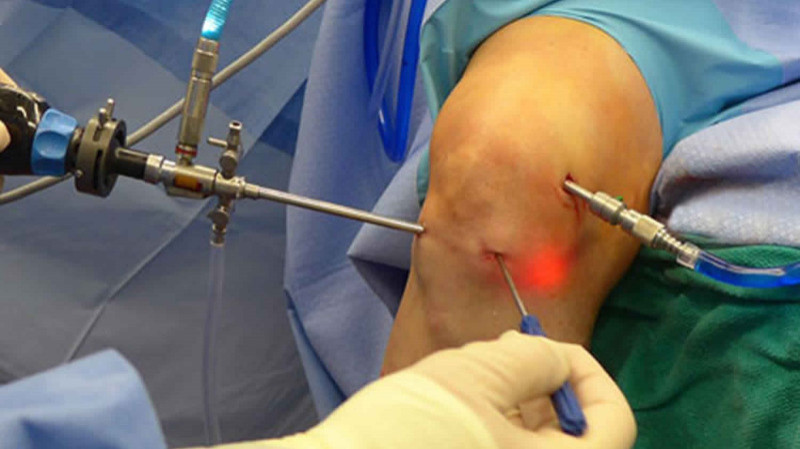Knee Arthroscopy Surgery in Gorakhpur
Advanced & Minimally Invasive Treatment by Top Knee Arthroscopy Surgeons in Gorakhpur
If you’re suffering from persistent knee pain, stiffness, or injury-related issues, knee arthroscopy treatment in Gorakhpur could be the minimally invasive solution you need. At our center, we offer the best knee arthroscopy treatment in Gorakhpur led by skilled surgeons using advanced technology to diagnose and treat knee problems with precision and care.
What is Knee Arthroscopy?
Knee arthroscopy is a modern surgical technique that uses a tiny camera (arthroscope) to view, diagnose, and treat issues inside the knee joint. This approach allows for smaller incisions, quicker recovery, and minimal tissue damage.
We specialize in:
Knee Arthroscopy Surgery in Gorakhpur for ACL/MCL tears, meniscus injuries, and cartilage damage
Diagnostic arthroscopies for unexplained knee pain or swelling
Same-day procedures with rapid recovery and discharge

Why Choose Dr. Vatsal Khetan – for Knee Arthroscopy in Gorakhpur?

Best Knee Arthroscopy Treatment in Gorakhpur
Recognized for quality care, expert diagnostics, and excellent outcomes

Experienced Knee Arthroscopy Surgeons in Gorakhpur
Our orthopedic team is led by specialists trained in advanced arthroscopic techniques

Modern Facilities
Equipped with high-definition arthroscopy systems and a dedicated surgical suite

Personalized Rehab Programs
Post-surgery physiotherapy tailored to ensure fast recovery and joint mobility
What Conditions Can Be Treated with Knee Arthroscopy?
Our knee arthroscopy treatment in Gorakhpur effectively addresses
If you're considering knee arthroscopy surgery in Gorakhpur, our experts will guide you through every step — from diagnosis and procedure to complete post-operative recovery.
Recover Better with Expert Knee Arthroscopy Treatment in Gorakhpur
Your knee health is our priority. With our best knee arthroscopy treatment in Gorakhpur, we ensure

Meet the Leading Knee Arthroscopy Surgeons in Gorakhpur
Our clinic is home to some of the most trusted knee arthroscopy surgeons in Gorakhpur - Dr. Vatshal Khetan , known for their patient-focused care and minimally invasive expertise. Each case is carefully reviewed and handled using the most advanced, evidence-based practices.
Looking for reliable, expert-led knee arthroscopy surgery in Gorakhpur? Book your consultation today and meet our team of top knee arthroscopy surgeons in Gorakhpur for the right diagnosis and advanced treatment.
Knee Arthroscopy Surgery by Dr. Vatsal Khetan – Advanced Invasive Treatment in Gorakhpur
If you’re dealing with persistent knee pain, swelling, or restricted movement, Knee Arthroscopy could be the solution you need. Performed by Dr. Vatsal Khetan, one of the most trusted orthopedic surgeons in Gorakhpur, this minimally invasive surgery allows for accurate diagnosis and effective treatment of various knee joint problems with faster recovery and less pain.
Benefits of Knee Arthroscopy Surgery in Gorakhpur:
1. Minimally Invasive Procedure
Knee arthroscopy is performed using small incisions and specialized instruments, which means less tissue damage, minimal scarring, and a quicker recovery compared to traditional surgery.
2. Accurate Diagnosis & Targeted Treatment
Whether it’s a torn meniscus, damaged cartilage, or loose fragments in the joint, arthroscopy enables precise identification and correction of the problem inside the knee.
3. Faster Recovery Time
Patients typically experience shorter hospital stays, faster wound healing, and a quicker return to daily activities and work.
4. Less Pain and Swelling Post-Surgery
Due to its minimally invasive nature, patients usually experience less postoperative pain, reducing the need for prolonged medication.
5. High Success Rate
With advanced techniques and expert surgical precision, Dr. Vatsal Khetan ensures a high success rate and long-term relief from knee discomfort.
FAQ
What is Knee Arthroscopy Surgery?
Knee Arthroscopy is a minimally invasive surgical procedure used to diagnose and treat knee conditions through small key-hole incisions. Using an advanced arthroscope camera, Dr. Vatsal Khetan, a leading orthopedic surgeon in Gorakhpur, performs precise treatment with less pain, faster healing, and minimal scars compared to open surgery.
Which knee problems can be treated with Arthroscopy in Gorakhpur?
Knee Arthroscopy is commonly used for:
• Meniscus Tear
• ACL/PCL Tear
• Cartilage Damage
• Ligament Injuries
• Loose Bone Fragments
• Synovitis & Early Arthritis
This advanced technique provides quick relief and restores knee function efficiently.
How long does recovery take after Knee Arthroscopy Surgery?
Most patients go home the same day and can walk within 24–48 hours. Full recovery usually takes 2–6 weeks, depending on the severity of the condition and physiotherapy. Under the guidance of Dr. Khetan’s rehabilitation program, patients regain normal knee movement faster.
Is Knee Arthroscopy better than open surgery?
Yes. Arthroscopy offers clear advantages:
1. Small cuts
2. Less pain & swelling
3. Early discharge
4. Faster return to daily activities
5. Lower risk of infection
That’s why many patients prefer Knee Arthroscopy in Gorakhpur for sports and ligament injuries.
Who is the right candidate for Knee Arthroscopy?
Patients with knee locking, instability, sports injury, swelling, cartilage tear, or pain unresponsive to medicine/physiotherapy are ideal candidates. Early diagnosis by Dr. Vatsal Khetan helps prevent long-term joint damage or arthritis progression.
How much does Knee Arthroscopy cost in Gorakhpur?
The cost depends on the injury type and required treatment. Dr. Khetan offers affordable knee arthroscopy surgery using advanced equipment to ensure safe and effective results for patients in Gorakhpur and nearby regions. You can easily contact the clinic for an estimate based on your condition.
